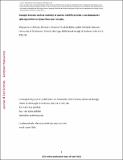Changes in intranuclear mobility of mature snRNPs provide a mechanism for splicing defects in spinal muscular atrophy
Abstract
It is becoming increasingly clear that defects in RNA metabolism can lead to disease. Spinal muscular atrophy (SMA), a leading genetic cause of infant mortality, results from insufficient amounts of survival motor neuron (SMN) protein. SMN is required for the biogenesis of small nuclear ribonucleoproteins (snRNPs): essential components of the spliceosome. Splicing abnormalities have been detected in models of SMA but it is unclear how lowered SMN affects the fidelity of pre-mRNA splicing. We have examined the dynamics of mature snRNPs in cells depleted of SMN and demonstrated that SMN depletion increases the mobility of mature snRNPs within the nucleus. To dissect the molecular mechanism by which SMN deficiency affects intranuclear snRNP mobility, we employed a panel of inhibitors of different stages of pre-mRNA processing. This in vivo modelling demonstrates that snRNP mobility is altered directly as a result of impaired snRNP maturation. Current models of nuclear dynamics predict that subnuclear structures, including the spliceosome, form by self-organization mediated by stochastic interactions between their molecular components. Thus, alteration of the intranuclear mobility of snRNPs provides a molecular mechanism for splicing defects in SMA.
Citation
Clelland , A K , Bales , A B E & Sleeman , J E 2012 , ' Changes in intranuclear mobility of mature snRNPs provide a mechanism for splicing defects in spinal muscular atrophy ' , Journal of Cell Science , vol. 125 , no. 11 , pp. 2626-2637 . https://doi.org/10.1242/jcs.096867
Publication
Journal of Cell Science
Status
Peer reviewed
ISSN
0021-9533Type
Journal article
Description
This work was funded by the Wellcome Trust (grant ID WT078810MA)Collections
Items in the St Andrews Research Repository are protected by copyright, with all rights reserved, unless otherwise indicated.

